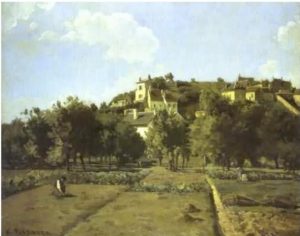R484 – L’Hermitage à Pontoise 1881 (FWN159)
Pavel Machotka
(Cliquer sur l’image pour l’agrandir)
In L’Hermitage à Pontoise, below, Cézanne’s touch is vertical and horizontal in all areas except the roofs; here, unusually, it adapts veryclosely to the planes that it represents. An interplay of static and dynamic touches, when used with less well ordered motifs, would be playful and quirky, but with a motif such as this one it risks becoming a grid. Cézanne stood in the middle of a narrow path between the vegetable beds and allowed it to rise seemingly straight up; this was unlike Pissarro, who had painted the site in 1867 and who stood from a few feet to the left and created greater depth. Cézanne then flattened the picture plane further by painting the path equal in width throughout, and, again unlike Pissarro, he kept the edges of the roofs close to the horizontal, painting them almost as a flat backdrop. Only the diagonal that starts in the lower left and rises through the little black roof suggests movement, and only the decorative interplay of the roofs suggests rhythm; our gaze can focus on the cluster of houses, where the space is dense and articulated.
Adapted from Pavel Machotka, Cézanne: The Eye and the Mind.
Pissarro a peint à de multiples reprises la colline de l’Hermitage. Exemple :




